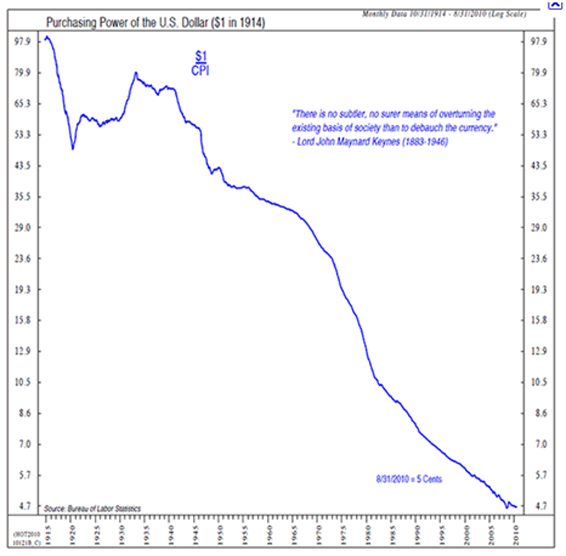Demetra finans blog
www.demetra.dk og www.teknisk-analyse.dk
Varer tiden som international reservevaluta 100 år?
Publiseret af John Yde i Analyse • 20-12-2010 10:03:30
Varer tiden som international reservevaluta omkring 100 år? Denne artikel argumenterer for det, idet den indsatte figur samtidig viser dollarens købekraft fra 1$ i 1914 til under 5 cent nu.

First and foremost, fiat currencies are nothing more than units of political promises. That can work for awhile, until the sheer weight of the lies (units of debt over the ability of the issuers to repay) brings the system down. The sovereign debt and hard-coded obligations of the U.S., Europe, Japan, and many other countries are now unpayable, period. With no way out, it’s either overt default or a continuation of the currency debasement that has been a dominant theme of the last 50 years.
And while it may seem that something as long lasting as a reserve currency will never be replaced, history has clearly demonstrated it can – and inevitably will.
In fact, the historical record shows that the typical reign of a reserve currency lasts just about 100 years. Consider…
Portugal’s currency was the most widely used in commerce between approximately 1450 and 1530, about 80 years. (While most people aren’t aware of it, Portugal was mind-bogglingly wealthy at the time, thanks to its “stealth” trade with Asia and elsewhere.)
Spain’s currency took the title between 1530 and about 1640, or 110 years.
The Dutch currency then stepped into the winning circle and stayed there from 1640 to about 1720 – 80 years.
The French franc followed, holding the currency crown for about 95 years, between 1720 and 1815.
After which the spread of the British Empire (often at the expense of the French) led to the English currency being the most widely used from 1815 to 1920, again about 105 years.
Which, in turn, led to the U.S. dollar’s turn as the global reserve currency, starting 91 years ago.
Of course, there’s nothing “mystical” about the length of time a currency is found to be particularly useful in global commerce. Rather it is that the nation that controls such a currency is given all manner of advantages. Out of the need for a simple medium for international exchange, other countries will go along to get along for as long as it suits. However, in time, especially if the issuing country gives in to the temptation to abuse the currency, using the reigning reserve currency begins to suit less and less, and a new reserve currency emerges.
While the U.S. dollar has certainly had a good run, in the historical context, its run has not been especially remarkable. And you can see for yourself in the chart here, almost straight out of the box in 1920, when it took the crown from the British pound, it’s been steadily degraded – most notably since the early 1970s when Nixon canceled its convertibility to gold. Since that time it has been on a slope every bit as steep as an Aspen ski hill.

First and foremost, fiat currencies are nothing more than units of political promises. That can work for awhile, until the sheer weight of the lies (units of debt over the ability of the issuers to repay) brings the system down. The sovereign debt and hard-coded obligations of the U.S., Europe, Japan, and many other countries are now unpayable, period. With no way out, it’s either overt default or a continuation of the currency debasement that has been a dominant theme of the last 50 years.
And while it may seem that something as long lasting as a reserve currency will never be replaced, history has clearly demonstrated it can – and inevitably will.
In fact, the historical record shows that the typical reign of a reserve currency lasts just about 100 years. Consider…
Portugal’s currency was the most widely used in commerce between approximately 1450 and 1530, about 80 years. (While most people aren’t aware of it, Portugal was mind-bogglingly wealthy at the time, thanks to its “stealth” trade with Asia and elsewhere.)
Spain’s currency took the title between 1530 and about 1640, or 110 years.
The Dutch currency then stepped into the winning circle and stayed there from 1640 to about 1720 – 80 years.
The French franc followed, holding the currency crown for about 95 years, between 1720 and 1815.
After which the spread of the British Empire (often at the expense of the French) led to the English currency being the most widely used from 1815 to 1920, again about 105 years.
Which, in turn, led to the U.S. dollar’s turn as the global reserve currency, starting 91 years ago.
Of course, there’s nothing “mystical” about the length of time a currency is found to be particularly useful in global commerce. Rather it is that the nation that controls such a currency is given all manner of advantages. Out of the need for a simple medium for international exchange, other countries will go along to get along for as long as it suits. However, in time, especially if the issuing country gives in to the temptation to abuse the currency, using the reigning reserve currency begins to suit less and less, and a new reserve currency emerges.
While the U.S. dollar has certainly had a good run, in the historical context, its run has not been especially remarkable. And you can see for yourself in the chart here, almost straight out of the box in 1920, when it took the crown from the British pound, it’s been steadily degraded – most notably since the early 1970s when Nixon canceled its convertibility to gold. Since that time it has been on a slope every bit as steep as an Aspen ski hill.